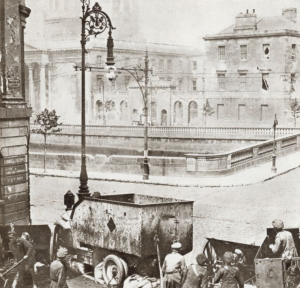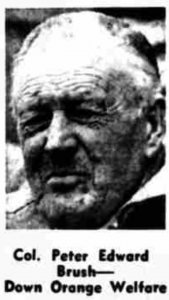October 27, 2020, by eburke
A 50 Years War? Republican and Loyalist Paramilitaries Active in the 1920s and the 1970s
The Greatest Weight?
My current Arts and Humanities Research Council-funded project is called ‘the Greatest Weight’. The title is drawn from Friedrich Nietzsche’s concept of ‘eternal recurrence’ – the ‘greatest weight’ being the realisation that we may be doomed to repeat our actions eternally. Since Ulster, unlike the rest of Ireland, experienced several periods of conflict in the 20th century, I wish to discern the practical, operational influence of one generation – knowledge, tactics – on another.

Nietzsche taking sides…
The influence of the men of the ‘Old IRA’ on the Provisional IRA, in terms of inspiration and morale, was of course considerable. Henry Glassie, in his wonderful anthropological study of a catholic community in South Fermanagh during the 1970s, described this charismatic lure at the local level, “With people moving past, laughing, jamming in the doorway, a quiet handsome young man who has known the terror of midnight roads, the engine’s hum, the feel of a makeshift bomb in his palms, stands, looking at no one, and says softly, ‘When I hear the old men sing, I love Ireland more.’”
But there were those men, republicans and loyalists, who fought twice or even three times in Ulster – playing active militant roles in the 1920s, 1950s and again during the 1970s. Here, I will briefly discuss three men who were active participants in events during the 1920s and again in the 1970s (there are others). These men are George Mussen Sr of Hilltown in County Down, James Conaty of Stradone in County Cavan – both republicans – and a leading loyalist, Lieutenant Colonel Peter Brush from Magheralin in County Down.
George Mussen
George Mussen joined the IRA at the age of 16 – in 1922 he appears on the rolls for Hilltown Company, 2nd (Newry) Battalion, 2nd Brigade, 4th (Northern) Division of the IRA. As well being a noted inter-county footballer, he was also a life-long republican. During the 1930s he was convicted of IRA related offences and he later stood as a republican candidate in County Down in the 1964 and 1966 elections (polling second and third respectively). In 1973 the Special Branch of the RUC wrote a report which suggested that 67 year old George Mussen was the most important explosives officer for the South Down and South Armagh area. Another intelligence report claimed that a network of middle-aged men brought explosives by rowing boat from Greenore in County Louth to a place near a lighthouse on the Down coast, where they were collected by Mussen. On this occasion the RUC tried, without success, to have Mussen imprisoned under an interim custody order – effectively internment. A later report noted that, “Unfortunately an ICO for Mussen was not forthcoming, and it only remains to be hoped that his advancing years will affect his dexterity…” These specific intelligence allegations against Mussen are unproven. However, local republicans do acknowledge his integral role in the wider provisional movement in South Down during the early 1970s. George Mussen was later suspected of being the target of a loyalist attack, which resulted in the death of Seamus Ludlow in 1976 (an independent inquiry into the Ludlow case was launched last month as part of the Barnard Review).
James Conaty
In October 1973 72 year old James Conaty, from Drumhirk, Stradone, County Cavan, appeared before the Special Criminal Court in Dublin charged with an array of crimes, including membership of the IRA, illegal possession of Garda documents and ammunition. Garda Superintendent James McNally told the court that during a search of Conaty’s home he discovered, “a number of confidential Garda circulars, the wax impression of a key … He also found a driving licence in the name of Eamon Ó Coileán of Youghal, Co. Cork; a number of blank insurance certificates; a copy of the Constitution of Óglaigh na hÉireann and the general orders issued to the IRA”. Conaty told the court that he had joined the Irish Volunteers in 1914, carried dispatches in 1916, been an active volunteer during the War of Independence and fought beside Seán Lemass in the Four Courts in 1922 (Conaty claimed that Lemass saved his life at one point during the battle).

Fighting at the Four Courts, June 1922
Some of these claims are difficult to verify – however, a James Conaty from the Lavey area of Cavan is listed in a British Army intelligence report as attending an IRA training camp in November 1921. Conaty was born in the United States and moved back there in 1935 where he was a key organiser in Clan na Gael, raising funds for a variety of republican campaigns and causes. Conaty returned to Cavan in 1969, where he continued his involvement in the republican movement. During sentencing, the judge noted his advanced age and the fact that his wife was unwell; although Conaty was found guilty of possession of stolen Garda documents and the ammunition charge, he was not convicted of the more serious charge of IRA membership. He received a sentence of 12 months in prison, suspended for two years.
Peter Brush and Down Orange Welfare
At the onset of Northern Ireland’s Troubles, Lieutenant-Colonel Peter Brush was a septuagenarian former army officer who had served as a young lieutenant in the Rifle Brigade during the British Army’s campaign against the IRA in 1920 and 1921. In his memoirs Brush describes a number of operations against the IRA in Dublin and in Donegal (he also guarded the Customs House shortly after it was burned in May 1921 and the Bank of Ireland on College Green). Brush retired from the army in 1946 and returned to the family estate at Drumnabreeze, County Down, a few miles outside the town of Lurgan. He later served as a High Sheriff, Deputy and Vice Lord Lieutenant of County Down, entertaining the Queen and the royal family during their visits to Northern Ireland. He was also chairman of the County Down Territorial Army (TA) Association and Northern Ireland’s representative to the Executive Committee of the TA. According to Brush, in 1971 he was approached by the grand master of the Orange Order in Down, who asked him to form a paramilitary organisation, one that would ensure that if the security situation in Northern Ireland deteriorated significantly, unionists in the county “would have a cadre of men ready to meet the unforeseen.” Brush established Down Orange Welfare, recruiting former servicemen in the county to run the organisation.

By early 1973 the British Army estimated that DOW had recruited between 1000-1,800 members. Despite mounting evidence that the organisation was working closely with the UDA and the UVF, the British government and the military largely ignored the organisation. DOW later joined the UVF and the Red Hand Commando in the Ulster Loyalist Central Coordinating Committee as part of the militant response to the Sunningdale Agreement in December 1973. Paramilitary organisations such as the UDA, UVF, USCA and DOW played an important role in mobilising the Ulster Workers’ Council strike in May 1974 that collapsed these institutions.
In 1979 Bill Hannigan, a former soldier and one of DOW’s leading commanders, was convicted of a variety of arms offences in relations to his effective role an armourer for the UDA and the UVF (including in the Portadown area). A lathe used for turning gun barrels was discovered at a farm near Kircubbin on the Ards Peninsula (24 weapons, a variety of gun parts, 42 magazines and 1,497 rounds of ammunition were also seized by the police). After Hannigan’s conviction, Colonel Brush petitioned unsuccessfully to the Northern Ireland Office for “… a Queen’s pardon for this old soldier”. An irritated Brush later wrote that “… Lord Gowrie replied to me through a secretary that he was unable to help.” Nevertheless, in the summer of 1980, barely six months after Hannigan’s conviction, military headquarters in Northern Ireland organised a party in Brush’s honour to celebrate the 60th anniversary since his commissioning as an officer in the British Army. The event was hosted in Lisburn by the Commander Land Forces Northern Ireland, Major General James Glover and the Commander of 39 Brigade, Brigadier David Ramsbotham. Such an indulgent attitude to DOW’s leader was consistent with the security forces’ relationship with the paramilitary organisation during the decade or so of its existence.
Inter-generational influence
It is remarkable to think that in the early 1970s Peter Brush and George Mussen (both of whom spent much of their childhood near Dromore) would emerge at the forefront of militant movements in County Down. They – like James Conaty – may be exceptions but they remind us that this revolutionary (and counter-revolutionary) generation had not gone away. Their presence, as well as their example, could still turn events.
For more on Down Orange Welfare and loyalist cross-border violence my recent article in Terrorism and Political Violence is available here.

Edward thank you for the insightful blog.
Very pleased that you enjoyed it Brent.
[…] another subject entirely, Edward Burke wrote a really interesting post for his University of Nottingham blog on political violence in Ulster. The subject is “A 50 […]
Great Post. From where did you obtain this information?